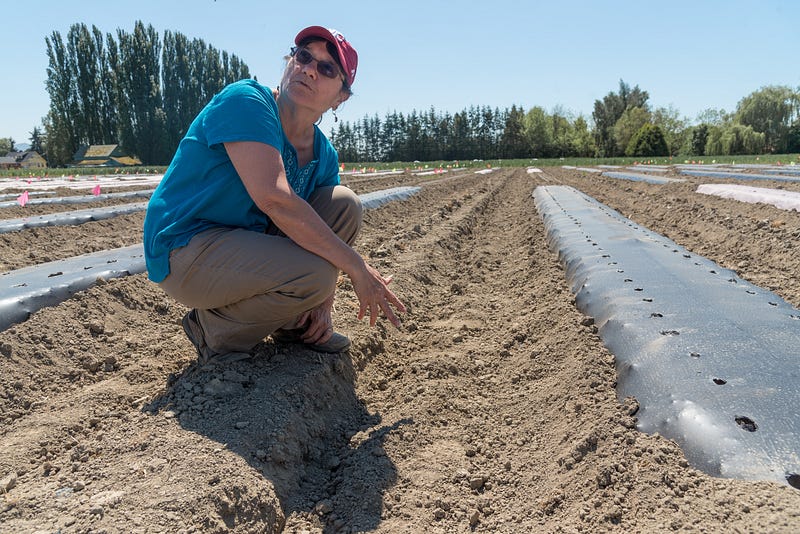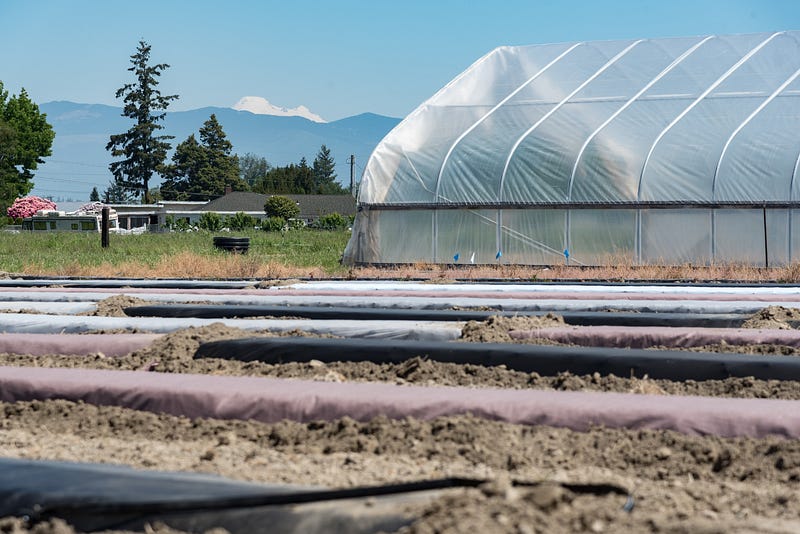Breaking Down the way Plastics Break Down
Biodegradable plastics aren’t always as eco-friendly as you thought
Story by JOHN SIMMONS | Photos by MATTHEW TANGEMAN

The plastic was not as biodegradable as the farmers expected.
Across the country, farmers cover their fields with plastic sheets to keep the soil warm, moist and weed-free. And since the plastic was labeled biodegradable, some farmers plowed the plastic into their fields, expecting it to break down and disappear.
But it wasn’t degrading. Instead it filled the soil with pieces of plastic, damaging machines and clogging drains.
And the problems get bigger as the plastic gets smaller.
Western chemistry professor Marion Brodhagen has been working with biodegradable plastics for over 10 years. She began working with them when the farmers started asking why their biodegradable plastic sheets weren’t breaking down. She was part of a team of scientists who worked to figure out how biodegradable these plastics really were.
“We had test sites in Mount Vernon, in Texas and in Tennessee and we tested what was on the market at the time. We put stuff in the ground and then we would take it out and analyze it for degradation, all the way across two years,” Brodhagen said. “And at the end of the two years, some of those plastics never visibly degraded, even though they were labeled biodegradable.”
Western engineering professor Mark Peyron works with Brodhagen to test how plastics degrade. He and his students develop tests to observe how plastics break down in different conditions.
“I’ve been working on just trying to do measurements on how plastics degrade in the environment and to be able to measure them in a fundamental, molecular way,” Peyron said.
“Molecular” is an important distinction because some plastics labeled “biodegradable” break down physically, but not on a molecular level. They break into smaller pieces, but the pieces are still there, said Carol Miles, professor of horticulture at Washington State University.
“What those products are is they’re actually made up of plastics, so just your standard plastic molecules, and then those molecules are joined together by biodegradable [bonds] and that bond breaks into fragments,” Miles said. “And so those products are not biodegradable.”
Plastics in the ground can be just as harmful as plastics in the oceans.
“Pollutants will leech off of those plastics that have been in the ocean for years…into the animal’s tissues and cause them to get sick,” Brodhagen said. “So there’s no reason to think that if you pollute terrestrial ecosystems with plastic the same way, they’re not also picking up toxins and getting into the soil.”
Researching plastic breakdown goes beyond agriculture, Miles said.
“Many plastics end up on the ground in one way or another, so if you think about plastic pollution, it’s any plastics that are being discarded onto the ground in the environment, that gives us in agriculture an opportunity to research that soil environment where plastics are being discarded,” Miles said.
Plastics that aren’t fully biodegradable can cause harm, but truly biodegradable — or compostable — plastics have their own problems.
In order for something to be compostable, it must be able to chemically degrade until 90 percent of the plastic has been broken down, Brodhagen said.
But most people don’t realize that composting requires specific circumstances, namely the correct microbes to eat the plastic, and heat.
“People interpret [compostable] as meaning you can just put it into soil and it will just go away, or you can leave it on the side of the road because it’s biodegradable, but it won’t, because it’s not in that warm condition,” Brodhagen said.

A study from Mendel University in Brno, Czech Republic and the Warsaw University of Life Sciences explained some reasons why plastics don’t degrade like they’re supposed to.
“Compostable plastics require specific levels of moisture and oxygen for initial reactions to make the polymers consumable by bacteria. These conditions are usually only found in larger, industrial-commercial facilities where materials are regularly turned, and usually have been pre-processed, often shredded,” author Dana Adamcova wrote.
The study went on to say that misconceptions about composting conditions is why plastics don’t break down in bins at home.
“Reports of failure to perform by compostable-labeled plastics in at-home composting environments are common. Inadequate temperatures in these smaller piles, so that the key reaction for degradable/biodegradable plastics is not initiated, are thought to be the reason for much of the poor results,” Adamcova wrote.
Regulations say not all of the plastic in a compostable item needs to break down, said Brodhagen. Leftover fragments cannot be more than two millimeters.
“The problem is that some plastic can be retained, so if only 90 percent is turning into carbon dioxide or water, or there are fragments that are smaller than two millimeters — those are called microplastics and those are things that can get into the food chain,” she said.
In either case, with nonbiodegradable plastics fragmenting, or with compostable plastics not breaking down all the way, the microplastics can get into the ecosystem.
Another problem with compostable plastics is the inconsistency in how they are collected and processed.
“You can go up to the [Viking] Union and you can watch where people throw stuff. There’s not a big incentive to get the right waste into the right container. And people here aren’t really trained to do that,” Brodhagen said. “In some European countries, everywhere you go, there will be uniformly colored bins: this color for recycling, this color for compost, this color for paper, and people just know, ‘Oh yeah, throw it in here,’ and here, Western’s compost program is different from what you might find some other place in Bellingham. And people don’t really know what goes in and what doesn’t go in.”
Despite the problems with compostable plastic, Miles believes it is worth pursuing and developing.
“I think society worldwide really has to look at our use of plastic, and we have to start considering other ways to manage those plastics,” Miles said. “And I would say in addition to management, we really have to consider other products that are biodegradable.”
Developing new degradable plastics is difficult to regulate. Brodhagen acknowledged this difficulty in a report she co-wrote in Environmental Science and Policy.

“Policy solutions must strike a balance so as not to be so rigid that they stifle future innovations in biodegradable plastic film mulches, nor so laissez-faire that they lead to pollution of the world’s most productive soils with plastic residue,” she wrote.
Collaboration between scientists in different fields is the best way to solve the plastic problem, Brodhagen said.
“One of the things I really enjoy about my work is I get to work with engineers and agricultural scientists, farmers, plastic producers, and we all get to talk and see this problem from everybody’s point of view,” she said. “And I think we can get a much better grasp on the problem than if just one person is thinking about it.”
